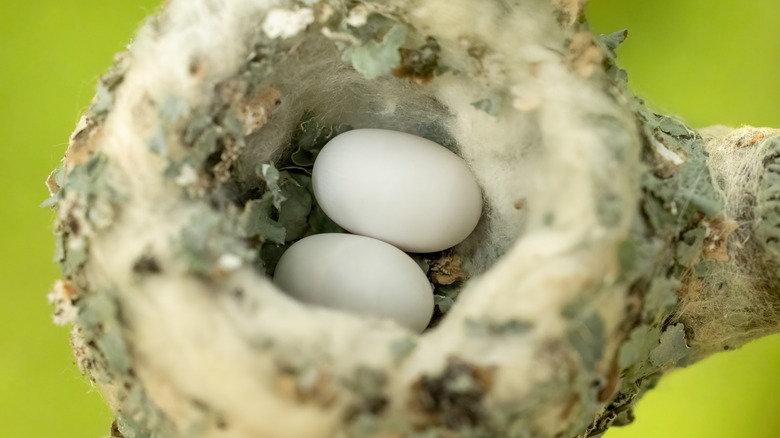What To Do If You Find A Hummingbird's Nest In Your Yard
While the exact timing depends on region and species, hummingbirds generally nest during the spring and summer. A hummingbird nest is primarily made with smaller twigs, leaves, and plant fibers. They may also use a bit of silk from spiderwebs to create their small nests. Together, these materials can create a safe haven for eggs and young hummingbirds, while also stretching to accommodate growth. On average, hummingbird nests are built between 10 and 90 feet off the ground, depending on whether they're located in large shrubs or in tall trees. Generally, hummingbird nests are hard to spot with the naked eye, but if you do see one of their creations in your yard, you must view it from a distance only.
In the U.S., it is illegal to touch a hummingbird nest. This includes removing or relocating one. Doing so can disrupt the nesting process and put hummingbirds in danger. If you suspect there may be a hummingbird nest in your yard, one of the first clues is spotting a female hummingbird going back and forth to a single spot in a tree or shrub for several days in a row, as it can take up to one week for them to build a nest. You may also be able to confirm the presence of a hummingbird nest with a pair of binoculars.
How to help protect hummingbirds during nesting season
Once you have spotted a hummingbird nest in your yard, you must leave it alone. Even if you're concerned about it being in a poor location, touching the nest can put the birds in jeopardy. Also, getting too close to the nest can garner the attention of some predators that could be eating hummingbirds in your yard. Instead, give the hummingbirds space and observe them with binoculars instead. If you're lucky, you may even see their small, navy bean-sized eggs or young hatchlings. According to United States law, bird nests may only be removed or relocated if they are inactive. In the case of hummingbirds, you would need to wait several days to make sure there is no activity and that all fledglings have left the nest.
On average, once hummingbird eggs hatch, the young birds will leave the nest after 18 to 28 days. You can help support hummingbirds as well as their future fledglings by creating a hummingbird nest-friendly habitat. This includes a clean, nectar-containing feeder and native plants for sources of food. Providing a source of clean water can also support hummingbirds in your yard during nesting season, maybe even helping to encourage them to come back next year.

